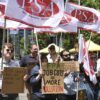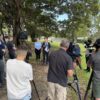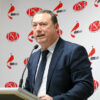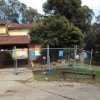The State Government is applying a crude approach
to budget issues.
When NSW Labor won the 2023 state election, NSW’s public servants had reason to feel relieved, even optimistic after working through 12 years of Coalition privatisation, the wage cap, job insecurity, and armies of consultants taking public sector jobs.
The PSA had liaised with shadow ministers during the 12 years of anti-public sector policies, and, with a new Premier in Macquarie Street, lines of communication with government were now open where they had been non-existent before the Labor win.
Premier Chris Minns made promises. It would be naive to place stock in any politician’s election promises, but Minns’s promises for public sector employees were not grand. They were simply what public servants are entitled to: salaries which keep up with inflation, and decent job security.
For the PSA, it was first things first; drop-kick the wages cap and take a serious look at the cost-of-living pressures on public sector workers. Then bring our members unfairly under-graded up to an appropriate level.
General Secretary Stewart Little and the industrial teams at the PSA went in hard on these issues in Labor’s first year. And the wins stacked up: wage rises for all public sector workers covered by the PSA, and NSW Sheriffs, Special Constables, Child Protection Workers and Grooms were all re-graded up to match the work they perform. It was a good first year of government for public sector workers. Nothing came automatically or without resistance, but there was a level of understanding not present for the 12 years prior.
And the PSA and Labor were on the same page with some major issues in the public sector: it is too top heavy, and there are too many consultants. The Premier promised to cut the senior executive service by 15 per cent, and agencies were required to use public servants, not consultants on projects and strategies. Further, public servants will be redeployed rather than be made redundant. Something the PSA had been campaigning on for the past 12 years to stop the brain-drain and loss of corporate knowledge in the sector.
This year has turned out to be a year of reckoning for the NSW public sector. Treasurer Daniel Mookhey’s cautious budget revealed a government overcommitted in capital projects, and setting its sights on workers’ compensation reforms. Ministers were ready to slash their portfolio budgets this financial year, ahead of the coming generous budgets which will lead into the 2027 election cycle.
There has been no major restructuring and redundancy programs in the state public sector until this year.
Create NSW, the administrative, financial, and directive hub of the cultural sector of NSW, announced in June that the agency will cut a quarter of their workforce.
“The PSA was provided with a Change Management Plan, which was a confusing and vague document” said Mr Little. “The PSA industrial team and delegates realised straight away that the agency had not followed its own Change Management Plan policies, and effectively had provided an incomplete document.
“Delegates, members and the PSA have been working with Create to redesign the proposed structure to not only reduce the number of staffing cuts, but to work more efficiently for the government, proving that wins are definitely possible when there is solidarity. There remains work to be done to refine the structure, and the government needs to be far clearer and more forthcoming with the detail of their intention for Create NSW.”
In July this year came the big one; Transport for NSW (TfNSW). Like Create NSW, TfNSW is one of Minister John Graham’s giant portfolio of departments. The PSA and Minister Graham do agree on one thing when it comes to TfNSW; the agency is bloated and needs to trim the fat. TfNSW boasts the largest number of senior executives in the state: about one in four senior executives in NSW work for transport agencies.
However, when it came time to roll out the cuts, Minister Graham didn’t target the top rung, instead announcing that 950 rank and file and middle management roles will go. That is definitely not where the swollen salaries budget and inefficiencies are at TfNSW, but if the government can cut a record number of workers in one giant restructure, maybe they can make an impact on the budget.
Mr Little stated, “The senior executives at TfNSW are not going to drive the breakdown trucks, coordinate traffic, or repair electrical and mechanical faults though, so the PSA is unsure how the agency will run after the cuts are complete”.
The PSA has put several alternative options to TfNSW, and negotiations are ongoing at present.
Late in July PSA members were hit with another blow. This time delivered by the Department of Primary Industries and Regional Development (DPIRD), and of course hitting the regional areas of NSW particularly hard. These cuts, not only deep and excessive, also create enormous risks for the state. At time when biosecurity, climate change, and rural assistance after natural disasters are more essential than ever, the NSW government are taking a backhoe to the workforce who provide vital research, services and strategies for regional NSW, and the state as a whole.
The Department is planning to cut 266 jobs, all in regional areas of NSW, to make $22 million saving.
“Unsurprisingly, and unfortunately, all these jobs are Awards-based roles,” said Assistant General Secretary Troy Wright. “Workers, not senior executives. The bosses get to keep their jobs.
“If the Department really wanted to make significant savings they should start their cuts at the top. These executives are making up to six times more than our members. Getting rid of just one executive could save six jobs; jobs that are essential to the state. Doing critical research, not flying to the big smoke to meet with ministers.”
Two hundred and sixty-six people in nearly 40 regional towns across NSW are going to be out of a job this year if all these cuts go ahead. For many of these people redeployment is not a realistic option if they need to stay in the town they have settled in.
“If your home, kids at the local school, and partner’s employment are all linked to the town you live in, how can you be expected to take a job 500km away?” said Mr Little. “And many, if not most of these are specialist roles, such as scientists and researchers. They live and work where they are because that’s where the work needs to be done.”
Cuts to research vital to the future will also affect members in the state’s universities.
Throughout the state, a drop in student revenue has seen administrators sharpen their knives.
The University of Technology Sydney (UTS) will close its schools of education and public health under a multi-million-dollar restructure that will cut more than 1100 subjects. UTS plans more than 400 cuts.
These cuts are not only catastrophic for staff, they also mean the students cannot complete the courses they enrolled in.
“It is almost as if the universities have forgotten their role in teaching students,” said Mr Little.
A similar number of job cuts are planned for Western Sydney University to address a budget shortfall.
Charles Sturt University has announced significant job cuts, with a goal to cut its operating budget by $35 million by the end of 2027.
“The cuts, from government and universities, will have far-reaching, negative effects on our state,” said Mr Little. “We have an obligation to fight them, and to fight hard.”
















Leave a Comment
Your email address will not be published. Required fields are marked with *